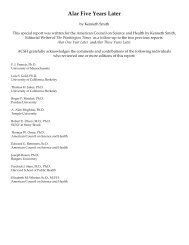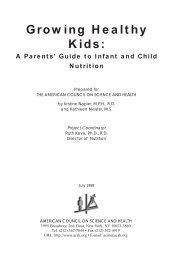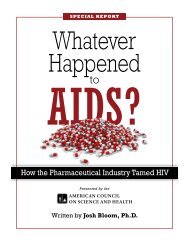The Role of Beef in the American Diet - International Meat Secretariat
The Role of Beef in the American Diet - International Meat Secretariat
The Role of Beef in the American Diet - International Meat Secretariat
You also want an ePaper? Increase the reach of your titles
YUMPU automatically turns print PDFs into web optimized ePapers that Google loves.
<strong>The</strong> <strong>Role</strong> <strong>of</strong> <strong>Beef</strong> <strong>in</strong> <strong>the</strong> <strong>American</strong> <strong>Diet</strong><br />
To reduce <strong>the</strong> possible current risk <strong>of</strong> acquir<strong>in</strong>g nvCJD from food,<br />
travelers to Europe should be advised to consider ei<strong>the</strong>r 1) avoid<strong>in</strong>g<br />
beef and beef products altoge<strong>the</strong>r or 2) select<strong>in</strong>g beef or beef<br />
products, such as solid pieces <strong>of</strong> muscle meat (versus bra<strong>in</strong>s or<br />
beef products such as burgers and sausages), that might have a<br />
reduced opportunity for contam<strong>in</strong>ation with tissues that might harbor<br />
<strong>the</strong> BSE agent. Milk and milk products from cows are not<br />
believed to pose any risk for transmitt<strong>in</strong>g <strong>the</strong> BSE agent.<br />
XI. Foot and Mouth Disease<br />
Foot and mouth disease is a viral <strong>in</strong>fection that can affect many<br />
types <strong>of</strong> animals, <strong>in</strong>clud<strong>in</strong>g cattle. It does not cause human illness, but<br />
people can carry <strong>the</strong> virus on <strong>the</strong>ir bodies, cloth<strong>in</strong>g, shoes, or personal<br />
items and <strong>the</strong>reby spread it to susceptible animals. <strong>The</strong> disease is<br />
extremely contagious and can quickly spread through and devastate a<br />
herd. Although <strong>the</strong>re hasn’t been a case <strong>of</strong> foot and mouth disease <strong>in</strong> <strong>the</strong><br />
U.S. s<strong>in</strong>ce 1929 (81), this disease has been present <strong>in</strong> some South<br />
<strong>American</strong> countries for many years and outbreaks occur regularly <strong>in</strong><br />
several o<strong>the</strong>r parts <strong>of</strong> <strong>the</strong> world. Thus, <strong>the</strong>re is great concern about <strong>the</strong><br />
possibility that <strong>the</strong> disease could be imported <strong>in</strong>to this country. Travelers<br />
return<strong>in</strong>g to <strong>the</strong> U.S. from countries where foot and mouth disease is<br />
prevalent are asked to declare all food and agricultural items <strong>in</strong> <strong>the</strong>ir<br />
possession and report any contact <strong>the</strong>y may have had with farms <strong>in</strong> foreign<br />
countries so that appropriate precautions can be taken to m<strong>in</strong>imize<br />
<strong>the</strong> risk <strong>of</strong> br<strong>in</strong>g<strong>in</strong>g <strong>the</strong> virus <strong>in</strong>to <strong>the</strong> country (82). Although <strong>the</strong>se precautions<br />
may not be convenient, <strong>the</strong>y are extremely important.<br />
Importation <strong>of</strong> foot and mouth disease <strong>in</strong>to <strong>the</strong> U.S. could have devastat<strong>in</strong>g<br />
effects on <strong>American</strong> livestock and wildlife.<br />
SPECIALTY BEEF PRODUCTS<br />
Some beef producers market beef that is labeled “natural,” “organic,”<br />
or “grass-fed.” O<strong>the</strong>rs produce beef products that conform to <strong>the</strong><br />
Jewish (kosher) or Islamic (halal) dietary laws. Consumers sometimes<br />
wonder how <strong>the</strong>se products differ from conventionally produced beef<br />
and whe<strong>the</strong>r <strong>the</strong>y are superior to o<strong>the</strong>r beef products <strong>in</strong> terms <strong>of</strong> nutrition<br />
or safety.<br />
<strong>The</strong> term “natural” has no <strong>of</strong>ficial legal def<strong>in</strong>ition, but when applied<br />
to most foods, it usually means that <strong>the</strong> food has been m<strong>in</strong>imally<br />
processed and conta<strong>in</strong>s no artificial flavors, colors, or preservatives.<br />
This description, <strong>of</strong> course, would apply to all conventionally produced<br />
fresh meats. To determ<strong>in</strong>e exactly what a producer <strong>of</strong> “natural” beef<br />
means by <strong>the</strong> use <strong>of</strong> <strong>the</strong> term “natural,” consumers need to read <strong>the</strong><br />
35










